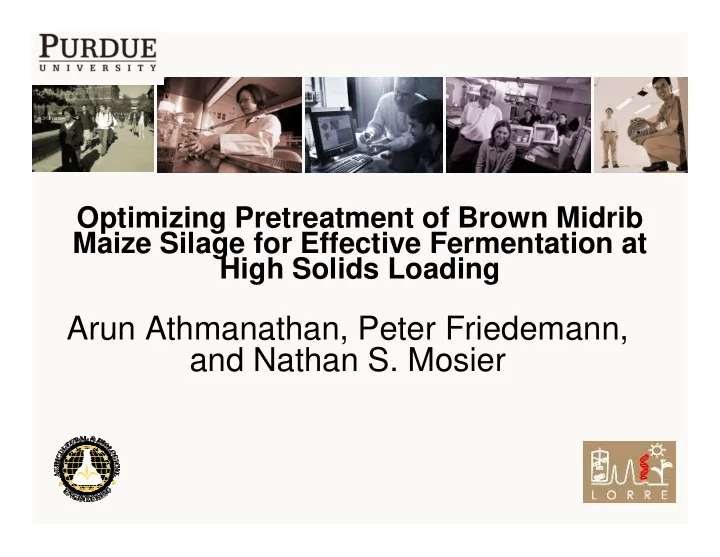

Optimizing Pretreatment of Brown Midrib Maize Silage for Effective Fermentation at High Solids Loading High Solids Loading Arun Athmanathan, Peter Friedemann, and Nathan S. Mosier
Acknowledgements • Research, Inc. (CPBR), U.S. Department of Energy (DOE) Prime Agreement no. DEFG36-02GO12026. • Dow AgroSciences for funding and providing stover and silage material • Wilfred Vermerris (U of FL) for providing the A619 • Wilfred Vermerris (U of FL) for providing the A619 maize stover • Purdue Agriculture Research Programs • Michael Ladisch (Purdue) • Yulin Lu, Isaac Emery, Youngmi Kim, Harini Kadambi, Lauren Quig, Erin Rosswurm, Scott Stella, and Linda Liu
Effect of Pretreatment of Corn Stover Representation of Physical Changes Cellulose Lignin Pretreatment Amorphous Amorphous Region Crystalline Region Hemicellulose Mosier et al, 2004
Goals: Liquid Water Pretreatment Determine conditions that : 1. During pretreatment �� ������������������������������������ �� ����������������������������� 2. After pretreatment �� ������������������������������������ �� ������������������������������������������
Autohydrolysis during Pretreatment of Lignocellulose at 190 C H k 1 k 4 Degradation k 3 X n X Products k 2 H* H = labile hemicellulose H* = recalcitrant hemicellulose X n = soluble xylans (oligosaccharides) X = xylose (monomer )
Liquid Hot Water Pretreatment at Lab Scale 33.75 mL Working Volume 4 ½ ” Swagelok Fittings and Endcap 1” Stainless Steel Tubing
COOH COOH NH 2 Lignin OH biosynthesis OCS-CoA OCS-CoA H 3 CO OH OH O O O bm3 bm3 H 3 CO H 3 CO OCH 3 OH OH OH bm1 H 2 COH H 2 COH H 2 COH H 2 COH H 3 CO OCH 3 H 3 CO OH OH OH H G S OH H 3 CO OH
Brown Midrib Maize › Known to have higher digestibility in ruminants – grown commercially for silage to feed dairy cows › Hypothesis: – ����������������������������������������������������� ������������������������������������������ ���������� ������������������������������������������ ����������
Improved yield of fermentable sugars from brown midrib corn stover (no pretreatment) 250 2x ! 200 g/g DW) 150 glucose (mg 100 50 0 control A619 bm1 bm2 bm3 bm4 bm1-bm3 bm2-bm3 bm3-bm4 All mutants in the same genetic background (A619)
Dry matter composition of wild type and BMR maize stover: Commercial Hybrids Composition Wild Type BMR CAFI (% dry mass) Maize Stover* Glucan 39% 41% 34% Xylan + Galactan 25% 27% 24% Arabinan Arabinan 2.8% 2.8% 3.1% 3.1% 4.2% 4.2% Acetyl 3.9% 3.5% 5.6% Lignin 22% 20% 17% Ash 4.1% 4.9% 6.1% Total 96.8% 98.5% 90.9% * Mosier et al., 2005a.
Pretreatment Method › Liquid Hot Water Pretreatment – ������������������ ��!��"�# – �$!� ° %&�'������������ – ��������������������������� – ���������������������������
Mass Balance Around Pretreatment: Xylan 100% 90% 80% 70% ial Xylan 60% % Initial X 50% 50% Furfural Xylose 40% Oligosaccharide 30% Solids 20% 10% 0% 10 15 20 25 30 10 15 20 25 30 (A) Wild Type Stover (B) bmr Stover Pretreatment Hold Time at 190C (minutes)
Enzymatic Hydrolysis of Unwashed, Pretreated Maize Stover BMR Pretreated W ild Type Pretreated 80 BMR W ild-Type 70 60 eld (%) 50 Glucose Yield 40 30 20 10 0 0 10 20 30 40 50 Hydrolysis Tim e (hours)
Summary of BMR Stover › Optimum pretreatment conditions same for both types › Lignin structure, but not amount, accounts for difference in enzymatic hydrolysis of untreated stover › Differences observed after pretreatment – (�)����'�� ��������������*!�� – (�)����'�� ��������������*!�� – +������������������������!� – (�)������������,!�������'�������������������� 14
Biomass Storage Moisture Continuum Dennis Buckmaster
Materials and Methods ›Silage – +�����������������������������������-�������'�����&� �������&�������������������������������������.������ – /�����������������������'��������'������������0����������� ����'����������������������������������-�������������� ����'����������������������������������-�������������� ���������������������������������������'�������������� ������������������ – ��������-������.���������1����������������������,�%������� ��������� 16
Composition of 2009 Silage (% dry matter) Component TMF BMR % (Dry Mass) % (Dry Mass) Starch 33.6 36.2 Cellulose 25.8 35.1 Xylan/Galactan 12.8 15.3 Arabinan Arabinan 1.3 1.3 2.0 2.0 Acetyl 0.5 0.5 Acid Insoluble Lignin 11.5 8.5 Acid Soluble Lignin 5.4 1.6 Ash 1.0 1.4 Mass Balance 92 101 17
Methods › Stainless Steel Reactors (35ml volume) › Loading 20 w/w % (200 g/L) › Sandbath heat up and temperature control › Enzymatic Digestion › Enzymatic Digestion – +������������ ���������# – �����2�����������3� – ��������%4�����5�'�������66� ���748"�������������,!� %(8"������9�����������#
Optimization of Silage Pretreatment 80% 70% Yield (24 hr) 60% 50% Glucose Yie 40% 40% BMR 30% Leafy TMF 20% 10% 0% Pretreatment Condition
Glucose/Xylose Fermentation Results BMR Pretreated and Pre-Hydrolyzed 90 80 Glucose 70 Ethanol n (g/L) 60 Concentration ( 50 40 30 20 Xylose 10 0 0 24 48 Time (Hours)
Summary › Brown Midrib variety of maize silage result in higher yields of glucose than regular varieties of maize before and after pretreatment › Ensiling cellulosic biomass has potential as a way to preserve feedstock quality for biofuels production between harvest seasons. seasons. › Liquid hot water pretreatment of maize silage requires less severity than dry maize stover (180C rather than 190C) to achieve similar results › Glucose released by enzymatic hydrolysis of pretreated silage is readily fermented to ethanol by S. cerevisiae
Thank you!
Recommend
More recommend